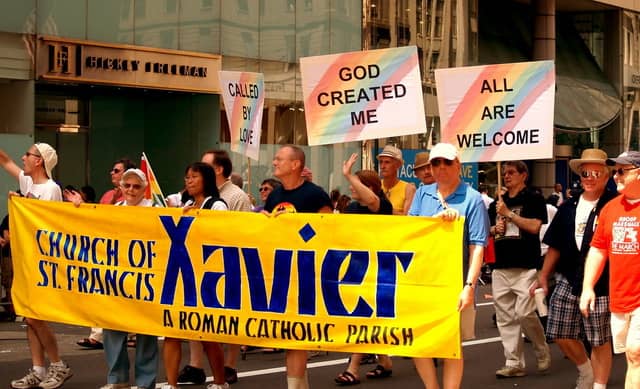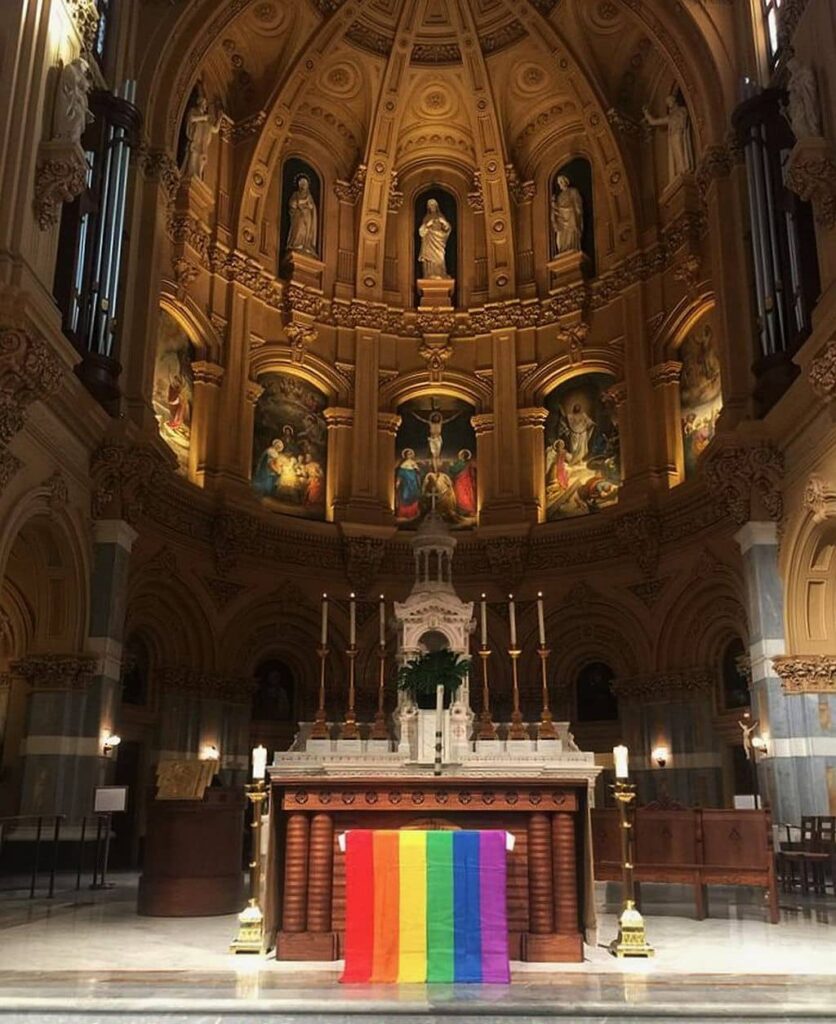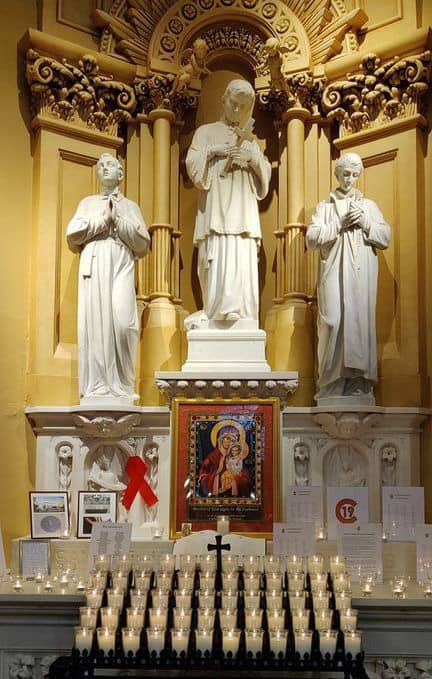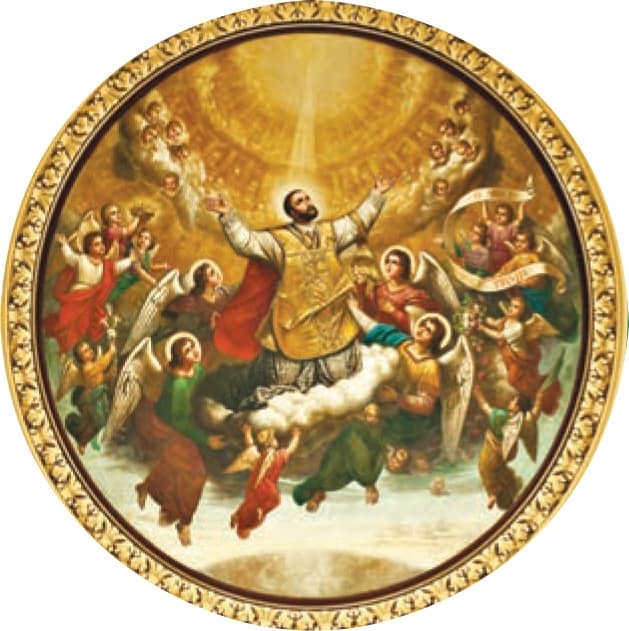Decades before Pope Francis inquired, “Who am I to judge?” there was the Church of St. Francis Xavier in New York City. For more than 40 years, lesbian, gay, bisexual, and transgender Catholics, who have felt rejected and diminished by the Catholic Church, have found solace and a spiritual home at 46 West 16th Street.
To this day, LGBTQ parishioners are an indispensable part of the Xavier community, serving as pastoral council members, Eucharistic and hospitality ministers, lectors, spiritual directors, and members of the parish’s many other ministries and committees. Our LGBTQ sisters and brothers volunteer at the Xavier Mission’s Welcome Table, bring spiritual care to the sick and homebound, and advocate for human rights, including those of women and refugees. In these capacities, they act as true disciples of Jesus, in their efforts to live the Gospel of Mercy and Justice.

Xavier and Dignity
In the mid-1970s LGBTQ people were seriously oppressed by both church and society, and the evolving AIDS crisis dramatically impacted them as individuals and as a community. Xavier, under the leadership of the pastor of that time, offered Dignity space in what was then the Xavier Elementary School, and on November 4, 1978, its 269 members held their first meeting on Church ground. In 1979, Dignity was invited to celebrate Eucharist weekly in the church. They found a loving home and continued to hold meetings and services for nine years, until they were asked to leave in 1987 by the Archdiocese of New York.
Xavier and the AIDS crisis
The 1980s were a devastating decade for gay New Yorkers. Redden’s Funeral Home on West 14th Street was the first mortuary in the city to accept persons who had died of AIDS. Xavier was the first Catholic church willing to minister to those suffering with the then-fatal disease. Parishioners frequently visited AIDS patients at St. Vincent’s Hospital in nearby Greenwich Village, as well as in their homes. In 1986, Xavier was the first Catholic church to hold a memorial service for a man who had died of AIDS, Diego J. Lopez, who was a social worker, psychotherapist, and Vietnam War veteran. As clinical director of the Gay Men’s Health Crisis, Diego developed a training program for volunteers, which became a model for AIDS organizations around the country. In 1996, the first meeting of the Gonzaga HIV Support Group (with approximately ten members) took place in the church’s Mary Chapel. That same year, Xavier dedicated the altar with the statue of St. Aloysius Gonzaga to people with AIDS, which remains to this day as a prayer space for the entire parish.
Xavier and the Lesbian and Gay Ministries
On January 4, 1993, with initiatives first from Irma Levesque and Sister Ann Citarella, SC, and with the approval of the Jesuit Provincial and Xavier’s pastoral leadership team, the Gay Catholics Ministry (which included men and women) was born. In 1995, Catholic Lesbians created its own ministry to address the specific needs and issues of Lesbian women in the Church. In June, 1994 both ministries organized and proudly carried Xavier’s parish banner in the New York City Pride March for the first time. It was the only Catholic parish to take the bold step of marching under its name and doing evangelization and outreach. Since then, Xavier has marched every year except during the Pandemic, handing out church bulletins and brochures to the thousands of people on the sidelines and letting them know there is a Roman Catholic church that truly welcomes LGBTQ people.

In 2017, our LGBTQ Ministries expanded to include Xavier Outings, which address the faith journey, needs and concerns of young adult LGBTQ Catholics. The group focuses on celebrating their faith and building a welcoming, supportive community through social and spiritual activities. Two other activities that have become parish traditions are the annual LGBTQ Catholics retreat in November and the Christmas Gift-Wrapping Party sponsored by the Catholic Lesbians for children cared for by the New York City Department of Social Services.
The Church of St. Francis Xavier is a home for every seeker, regardless of sexual orientation, gender, marital, citizenship status, race, ethnicity, economic status. As we sing at Mass, “All are welcome in this place!”

Testimonials
Anonymous
I took a long hiatus away from the Catholic Church to journey towards self-love and acceptance with my sexuality, and to divorce myself from the rigid culture of the church. I eventually discovered the Jesuit community at The Church of St. Francis Xavier, who afforded me a sense of belonging and that I could be a modern, gay man and still go to Mass with less dissonance than ever before. I felt that I belonged at Xavier, and I quickly made friends with other queer people. The Xavier community provided an opportunity for me to touch my Catholic roots from a more secure, mature place. I still have many reservations about the Catholic Church but I have never trusted a parish more than Xavier. It is a beacon of light for New York City and the world.
Ann Citarella
My search for a safe church community in which I could fully be myself began over thirty years ago. I “found” Xavier and found a home. A small lesbian and gay group of which I was a part was in danger of ending. I prayed about what this would mean. We had a gift and could not lose it. So began the great struggle and joy of a fuller more engaged lesbian and gay group. A group that brought together some hurting souls, angry at a church which turned its back and refused to accept who we are, others seeking a sacred space to be Catholic and gay . . . or is it gay and Catholic?
Evenings spent talking about our experiences and our hopes led to seeing our place in this parish as valued members. Finding God in the midst of the ordinary, in the midst of pain, was uncovered. We modern mystics use our gifts to be the hands and hearts so needed in our gay community.
We started as a small group of lesbian and gay followers and have become women and men, leaders in our gay community and our Catholic Church. Amen ! Amen!
Mike Mattioli
I was born in 1926. Arithmetic tells me that I am now 96 years of age. I was born with three pre-existing conditions: I was (1) the son of immigrant Italian parents; (2) Catholic; and (3) gay. I was not given choices; it was a package deal. It was not always a comfortable or easy journey, but in retrospect, I inched increasingly towards an appreciation of the blending of my being.
In my earliest years, “gay” did not exist as a word. There were “homos” and “queers“ and “sissies.” My platonic, best-buddy relationships were not accused of that. After high school graduation, in June 1944, I was drafted into the Army where my intense male friendships remained platonic. It was not until August 1946, after my Army discharge and experiencing college and work, that I slowly began to gain an awareness and understanding of my complex feelings and stirrings which I identified as loving friendships but were viewed very differently by many others.
Our law enforcement agencies classified us as “criminal;” the military as “unfit;” the Catholic Church as “sinful and intrinsically disordered.” Until 1973, the psychiatric and psychological professions diagnosed us as “mentally disturbed.” In such an environment, it was not easy to be “fully yourself.” But along the way, we were joined and supported by other seekers, along with people who cared and supported us. I cared, too, and earned a bachelor’s degree, a master’s degree and a PhD in psychology, which has been my life’s work.
As a child, my mother saw to it that I got to Mass every Sunday, and I went without complaint. But the time came when going was mostly because of the obligation.
Then Vatican II happened: the altar rail disappeared; the altar was turned around and the priest faced the people; and it was in English! Nuns wore pretty dresses and showed their hair. It was needed oxygen, and following years were fruitful. “We are church”, the people said. Well . . . some churches and some people said this. Important limitations and exclusions survived in subtle practices. By habit, I continued to go to church on Sunday. I was present, an observer . . . but I still did not belong.
All my life, I have had the seeds of advocacy in me, and not just for me, but for “people causes.” I try to avoid being an “in your face person,” but I am persistent. I pause when necessary — but I do not give up! And I am not ambiguous.
Sometime around 1998, on a Pride Sunday, I was standing on Fifth Avenue watching the parade go by. I admired and respected those who were marching and their celebration and public declaration of personhood. I had never seriously considered participating myself – but then I saw a very large yellow banner announcing “Church of St. Francis Xavier–A Roman Catholic Parish.” Walking behind the banner were people carrying signs that said, “All are welcome.” Others raced along the sidelines of spectators distributing welcoming literature and words of welcome. I said to myself, “It’s some aberration. It won’t be here next year.”
I was wrong! They were there the next year, and I was informed that representatives of Xavier had been marching for several years. I decided I had to check out this church, and I did.
I went there to a series of Sunday Masses. The homilies were relevant and thought-provoking. The choir was a delight; the congregation was engaged and fully participating, and the Mass was truly celebrated. The announcements in the bulletin included meetings of the Gay Ministry and the Lesbian Ministry, alongside a wide range of other ministries and group activities.
I decided to go to the next meeting of the Gay Ministry. I was made welcome, and soon lost my “outside observer” status and became one with them. What was key to my readiness to engage was the message that each of us is on a personal journey and is entitled to be treated respectfully as a thinking adult.
Soon came the test I had for myself: the Pride March. Could I march down Fifth Avenue as a proud GAY Catholic with the message of welcome? I decided that now was my time. The morning of the march, we all attended Mass and our priest and congregation stood and gave us a blessing to go forth and evangelize. I showed up wearing large sun glasses and a big floppy hat! I hoped I would not be recognized as we marched past the building where I lived.
As we passed St Patrick’s Cathedral, our group paused, turned to face the big closed doors and said a prayer and marched on. Along the way, we were cheered and it felt good as bystanders reached out to shake our hands. The Episcopalian church in Greenwich village brought trays of cold water to refresh us. I’ve marched with Xavier the many years since. There is no doubt that we are respected and appreciated. I am not the only parishioner who found his way to Xavier through the march. The word goes forth:
You can be gay and Catholic! Now I was fully “out of the closet”!
It is difficult to imagine or to explain, but at Xavier, you are welcomed as you are. It is a caring and friendly environment. But we are not just sharing the same space with each other, with each person just doing their own thing. We are connected, together, caring for each other and the world around us. I think that if Jesus saw us, he would say, “You understood the message. Keep on going!”
Michael Orza
Long before an official ministry was formed, Xavier supported the LGBTQ community by inviting Dignity to celebrate the liturgy on Saturday nights after the vigil. In my coming out journey at age 43 in 1981, I attended the weekly liturgies in a Roman Catholic church, a rarity at that time. But worshipping in a church building was an important ingredient in accepting myself as a Gay Catholic.
Fast forward to 1996, when I learned of an active LGBTQ ministry at Xavier. I just needed my first Mass there to know that I had found the home that I had been seeking. Now, 25 years later, I drive two-and-a-half hours round trip every Sunday to worship my God, receive the Bread of Life and be with my chosen family at Xavier. I am free to be me, with no need to hide who I am.
The love and support I receive from so many members of the Xavier community, both gay and straight, strengthens my faith as a beloved child of God. I hope they feel the love that I am returning to them.
Xavier is such an integrated parish. Remarkably it is both ordinary in how everyone is accepted for who they are and extraordinary compared to many parishes where LGBT Catholics must continue to hide their identities.
Xavier’s many ministries, including but not limited to its LGBT ministries, provide a template for what any Catholic parishes should be achieving. Our motto of “All are welcome” are not empty words. It is the lived experiences we share as the children of God, as the living Body of Christ.
Melinda Spataro
I grew up in a conservative Italian Catholic home in Queens, New York. My childhood revolved around the love of family and devotion to my Roman Catholic faith. Growing up, my second family was my vibrant parish where there were activities for all, from the cradle to the grave. I engaged in the Roman Catholic educational trifecta–Catholic grammar school, high school and college. I dated many incredible young men. However, I always knew that I was different. Through introspection, mainly via those self-searching moments on my youth and college retreats, I could no longer run from my authentic self–that of being a gay woman. Now what?
It is important to note that I never thought God was the problem. I truly felt that God made me this way, perhaps to enable me to be more caring for those on the fringe. I always envisioned myself marrying a “local” boy, having three children, and carrying on my family’s and church’s traditions. I did not have any Catholic, gay role models. As I did not know of any “out” lesbians, I turned to literature to try to figure this out. Unfortunately, the lesbians I read about bore no resemblance to me or anyone in my world. I felt so lost.
As my faith was of utmost importance, I started attending non-Catholic gay and gay-friendly churches. Although welcoming and affirming, something was seriously missing. And then, miraculously, I found the Church of St. Francis Xavier. I took the giant leap and began my God-led journey to authenticity—starting with my first Xavier mass. I began attending the Gay Catholics group and found my people: good, loving people, as devoted to their faith as I to mine. Moreover, Xavier gave me the courage to move out of my childhood home, come out of the closet, date women and marry the love of my life.
Fast forward 30 years, I am happily married to an amazing woman who deeply shares my faith. I am as close to my family as ever and loved by my spouse’s huge Catholic family. We attend Xavier each Sunday and see our Catholic Lesbian group friends as family. In sum, all that I was afraid of losing, I have gained in abundance thanks to the Church of St. Francis Xavier.
God is so good.
Tess Thompson
Xavier is my home, and its parishioners are my family–and like all families, we are growing and changing all the time. I first came to Xavier looking to connect with fellow LGBTQ Catholics, and I was met with a welcoming embrace. That embrace just gets wider and deeper as we continue working to include the needs and presences of women, people of color, and other people who hold marginalized identities that have not felt valued by Catholic communities. Until we open our arms as wide as those of Jesus, we will not have opened them wide enough.
Thomas Volpicella
It was my good fortune over 20 years ago to have found the Church of St. Francis Xavier in Manhattan as a welcoming spiritual home. I grew up Roman Catholic and ultimately came to the realization that I was gay. As such, I never truly felt welcome in Catholic settings until I encountered the community at Saint Francis Xavier parish.
My experience has been that the Xavier community focuses on the gospel of welcoming the stranger and embracing those on the margins. It is such a joy for me to see people from diverse walks of life working and worshipping together to try to help make the world become a better place. This sentiment is manifested by the parish’s variety of ministries and outreach programs. Personally, I have found solace during difficult times, both public and private, at our parish. For example, I can remember the service following the 9/11 attacks and how it helped toward healing.
The sense of love and support that I have felt from the Xavier community over the years has been palpable and transformative for me in my faith journey. Although I do live quite a distance away, I look forward to regularly, and happily, attending Sunday services. I count the parish as a major blessing in my life.
